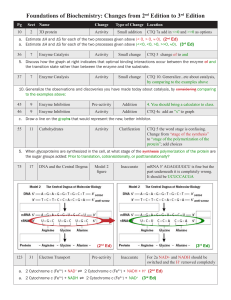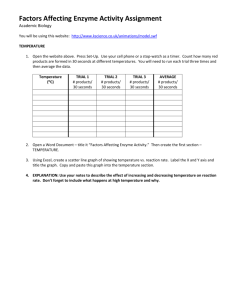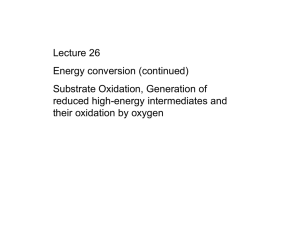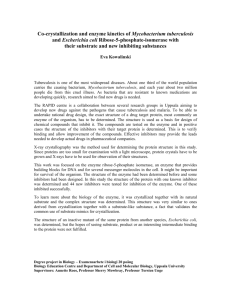ANSWERS TO REVIEW QUESTIONS – CHAPTER 03
advertisement
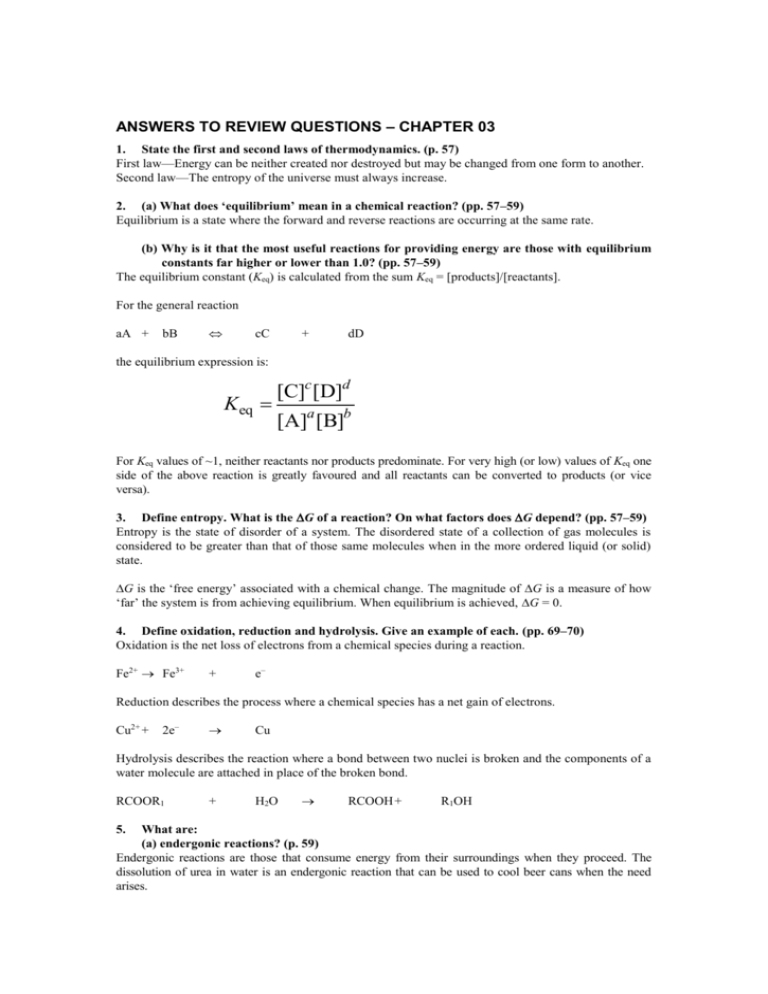
ANSWERS TO REVIEW QUESTIONS – CHAPTER 03
1. State the first and second laws of thermodynamics. (p. 57)
First law—Energy can be neither created nor destroyed but may be changed from one form to another.
Second law—The entropy of the universe must always increase.
2. (a) What does ‘equilibrium’ mean in a chemical reaction? (pp. 57–59)
Equilibrium is a state where the forward and reverse reactions are occurring at the same rate.
(b) Why is it that the most useful reactions for providing energy are those with equilibrium
constants far higher or lower than 1.0? (pp. 57–59)
The equilibrium constant (Keq) is calculated from the sum Keq = [products]/[reactants].
For the general reaction
aA +
bB
cC
+
dD
the equilibrium expression is:
Keq
[C]c [D]d
[A]a [B]b
For Keq values of ~1, neither reactants nor products predominate. For very high (or low) values of Keq one
side of the above reaction is greatly favoured and all reactants can be converted to products (or vice
versa).
3. Define entropy. What is the G of a reaction? On what factors does G depend? (pp. 57–59)
Entropy is the state of disorder of a system. The disordered state of a collection of gas molecules is
considered to be greater than that of those same molecules when in the more ordered liquid (or solid)
state.
G is the ‘free energy’ associated with a chemical change. The magnitude of G is a measure of how
‘far’ the system is from achieving equilibrium. When equilibrium is achieved, G = 0.
4. Define oxidation, reduction and hydrolysis. Give an example of each. (pp. 69–70)
Oxidation is the net loss of electrons from a chemical species during a reaction.
Fe2+ Fe3+
+
e–
Reduction describes the process where a chemical species has a net gain of electrons.
Cu2+ +
2e–
Cu
Hydrolysis describes the reaction where a bond between two nuclei is broken and the components of a
water molecule are attached in place of the broken bond.
RCOOR1
5.
+
H2O
RCOOH +
R1OH
What are:
(a) endergonic reactions? (p. 59)
Endergonic reactions are those that consume energy from their surroundings when they proceed. The
dissolution of urea in water is an endergonic reaction that can be used to cool beer cans when the need
arises.
(b) exergonic reactions? (p. 59)
Exergonic reactions are those that emit heat energy (or other forms such as light or electrical energy) to
the surroundings. Fire is a prime example.
6.
What is the basis of the specificity of enzyme action? Explain in terms of enzyme structure
why boiling inactivates enzymes. (pp. 60–65)
An enzyme is a catalyst produced by the protein production machinery of a cell. It acts by increasing the
rate of particular chemical reactions. The basis for enzyme specificity is molecular shape. The enzyme is
able to lower the activation energy of a reaction by holding substrate molecules in particular orientations
that lead to much increased reaction rates. Enzymes are proteins produced by the transcription of DNA
into RNA and the processing of RNA into proteins. Often they are large structures (molecular weights of
100 000 g mole–1 = 100 kDaltons) that consist of an agglomeration of a small number of lower molecular
weight subunits. These subunits are held together by intermolecular forces that are broken as the
temperature is increased. The rupture of the intermolecular bonds between the subunits results in a loss of
activity.
7.
Define ‘substrate’ and ‘active site’ of an enzyme. Describe the forces involved in binding the
substrate to the active site. (pp. 60–62)
The compound on which an enzyme acts is called a substrate. Enzymes recognise and bind a molecule
through the active site, where the polypeptides are from a specialised region where only the substrate
molecules can fit. Exposed R-groups of the amino acids in the active site and their arrangements
relative to each other determines the specificity of the enzyme to particular substrates.
8.
Match each term with an appropriate item from the list below (a–e): oxidation, reduction,
anabolism, catabolism, cofactor, coenzyme, substrate, isomerase, hydrolase, lyase.
(a) Compound acted upon by an enzyme—substrate (p. 60)
(b) Type of enzyme that causes geometric/structural changes in a substrate molecule—
isomerase (p. 68)
(c) Metal iron required by many enzymes—cofactor (p. 65)
(d) Conversion of ferrous ions (Fe2+) to ferric ions (Fe3+)—oxidation (p. 69)
(e) The breakdown of compounds in living cells—catabolism (p. 67)
9.
What is an electron carrier? Name three electron carriers and indicate their reduced and
oxidised forms. (p. 70)
The term ‘electron carrier’ seems to be a misnomer as the chemical species that acts in this way does so
by gaining or losing protons. The chemical term for a substance that acts as an electron carrier is a
‘mediator’.
Examples are: NAD (nicotinamide adenine dinucleotide), FMN and FAD (flavin nucleotides), the
Cytochromes (a family of compounds designated b, c1, c, a, a3).
Oxidised form
Reduced form
NADH
FADH2
FMNH2
NAD+
FAD
FMN
10. Calculate the net oxidation-reduction potential and the standard free energy change for each
of the following reactions written from left to right. Indicate whether or not the reaction will
tend to go spontaneously given the proper conditions. Use the equation G0 = -nFE0.
(a) NADH + H+ + 1/2O2 NAD+ + H2O (pp. 58–59)
NADH2+
0.5 O2 +
NAD+
2H+
+
+
2H+
2e–
+
2e–
H2 O
Net reaction
NADH2+ +
0.5 O2
NAD+
+
H2 O
(oxidation reaction) 0.32 V
(reduction reaction) 0.82 V
E = (0.82 + 0.32) = 1.14 V
G = –nFE
where
n
F
E
=
=
=
2
Faraday constant, 96485 Coulombs mole–1
1.14 V
G = –2.2 × 105 J mol–1
A negative and large value for G means that this reaction is spontaneous as written, and a long way
from equilibrium.
(b) Coenzyme Qox + 2H+ + 2{cytochrome a {Fe2+}] Coenzyme Qred + 2{cytochrome a
{Fe3+}] (pp. 58–59)
CoenzymeQox
+
Cytochrome a(Fe2+)
2H+
+
2e- Coenzyme Qred
Cytochrome a(Fe3+)
+ e-
(oxidation reaction) –0.17 V
(reduction reaction) –0.29 V
Net reaction (multiply the cytochrome reaction by 2)
CoenzymeQox + 2H+ + Cytochrome a(Fe2+) Coenzyme Qred + Cytochrome a(Fe3+) E = –0.46 V
G = –nFE
where
n
F
E
=
=
=
G =
8.9 × 104 J mol–1
2
Faraday constant, 96485 Coulombs mole–1
–0.46 V
A positive and large value for G means that the reaction is spontaneous in the reverse direction (as
written) and a long way from equilibrium.

